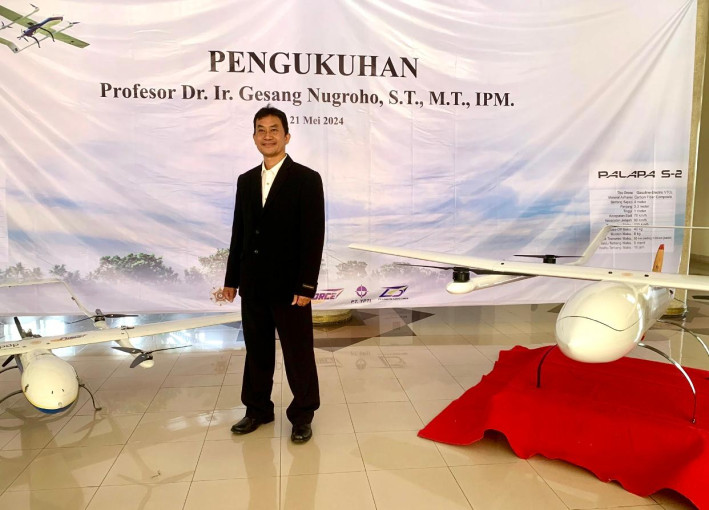
Two unmanned aerial vehicles (UAVs), Palapa S-1 and Palapa S-2, were showcased at the UGM Central Building on Tuesday (May 21). The Palapa S-1, developed over 2.5 years, can fly for 6 hours nonstop, while the Palapa S-2 can fly for up to 10 hours.
Both UAVs can be operated remotely and range from 50 to 300 kilometers, making them suitable for mapping, disaster monitoring, and surveillance activities.
These UAVs are the innovative work of Dr. Gesang Nugroho, a Mechanical Engineering lecturer at the UGM Faculty of Engineering (FT UGM), who was recently inaugurated as a professor.
After 12 years of developing UAVs, Professor Nugroho achieved a professorship and secured two patents related to composite molding using balloon pressure, named Bladder Compression Moulding (BCM).
In his statement to reporters, Professor Nugroho explained that the UAVs, measuring 2 meters and 3.3 meters, respectively, are equipped with autopilot systems and can navigate according to set coordinates.
“During flight, they can capture photos and videos sent to the ground control station. The Palapa S-1 can fly for 6 hours nonstop, while the Palapa S-2 can fly for 10 hours nonstop,” he said.
Professor Nugroho noted that the Palapa S-1 uses Wi-Fi telemetry with a range of up to 50 kilometers.
Although it has a flight range capability of up to 300 kilometers, photos and videos can only be communicated over shorter distances. In contrast, the Palapa S-2 uses satellite telemetry and offers unlimited capabilities, although it is still in development.
“The Palapa S-2 is not yet finished; it will be equipped with an autopilot system and satellite telemetry communication for unlimited range. Currently, we are still in the phase of building its body,” he explained.
Despite currently using 25-30% domestic components, Professor Nugroho is optimistic about the future development of UAVs in Indonesia. These UAVs are essential not only for military purposes but also for mapping, surveillance, disaster monitoring, and agricultural and plantation maintenance.
“We are encouraging the growth of the aircraft component industry and the manufacture of aircraft bodies from composites,” he emphasized.
Regarding the cost, Professor Nugroho mentioned that the UAVs he developed are much cheaper compared to foreign UAVs. Maintenance and repairs can also be done domestically.
“The price is much more economical. Similar UAVs are sold in Indonesia for up to Rp 3 billion. Our UAVs can be priced below Rp 1 billion,” he revealed.
In his inaugural speech, “Building Indonesia’s Unmanned Aerial Vehicle Industry,” Professor Nugroho highlighted the rapid advancement of UAV technology.
UAVs are no longer just sophisticated technological devices but revolutionary tools that change our perspective on the world. From military uses to various civil applications, UAVs are penetrating every aspect of society at an astounding rate.
He urged the public and government to support and use domestically researched products. Effective collaboration will ensure the continuous implementation of the Invention, Application, and Utilization (IAU) concept, fostering growth and development in the domestic manufacturing industry.
Author: Gusti Grehenson

